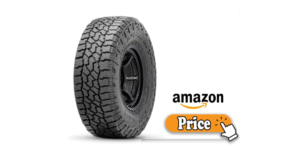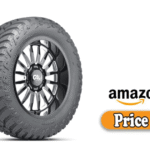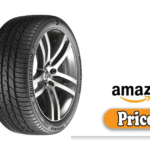Choosing the right set of tires can make or break your driving experience. Tires don’t just carry your car; they are the only contact with the road, influencing braking, cornering, comfort, noise, and safety.
Over the years I’ve tried multiple tire brands: premium, mid-tier, budget and one brand that repeatedly caught my interest is Falken. Their bold marketing, motorsports heritage, and broad model lineup make them a compelling choice.
In this article, I dive deep into:
- What I like about Falken tires
- What could be bet,ter
- My personal experience (on my own vehicle, in my environment)
- Design and engineering aspects
- Real-world performance (dry, wet, noise, wear, etc.)
- Build quality and durability.
- An alternative option to consider
- Final thoughts and recommendations
Throughout, I pay attention to Falken tire prices (in my region and internationally) and compare value versus performance. I also include a FAQ section to answer common questions.
My goal: You should come away with a grounded, honest sense of whether Falken tires are a smart buy for you, not just in theory, but in everyday life.
What I Like
1. Strong value proposition
One of the first things that attracted me to Falken was the price-to-performance ratio. While not ultra-cheap, Falken is generally more affordable than premium brands like Michelin, Bridgestone, or Continental, yet many of its higher models deliver competitive performance. For example:
- On Discount Tire, Falken’s Pro G5 Touring A/S is listed in the $70–$151 range per tire.
- More performance offerings like the Azenis FK510 are listed in higher brackets, but still below many flagship models from premium brands.
To me, that suggests you can often “punch above your weight” by paying less but getting solid performance. If you’re not chasing ultra-premium, Falken often gives you more bang for your buck.
2. Diverse product lineup
I also appreciate how Falken doesn’t lean in just one direction (performance, off-road, touring). Their product families Azenis, Ziex, Wildpeak, Pro, and Sincera cover a wide range of needs (summer high performance, all-season, all-terrain, touring). That gives flexibility depending on your vehicle type and environment.
3. Motorsports & engineering backing
Falken is not a “marketing-only” brand. It has roots in motorsports (drifting, racing) and is part of Sumitomo Rubber Industries, which invests in R&D. That heritage often trickles down to tread compounds, structure, and design elements that benefit consumers.
4. Decent reputation from users & testers
Reading reviews, I found many users praising Falken’s wet grip, handling, and off-road traction, especially in the Wildpeak lines. On Tire Rack, for example, lots of users say “very fair price for quality.” In off-road tests, the Falken Wildpeak AT4W drew positive comments about its balance between off-road ruggedness and on-road manners.
So overall, the “brand promise” often lines up with what real users report, not perfectly, but enough to be compelling.
What Could Be Better
No brand is perfect. Here are some of the criticisms and trade-offs I found with Falken.
1. Treadwear & durability concerns (for some models)
Some users report that certain Falken models wear faster than expected. For example, a user complained about Ziex CT50 A/S after ~20,000 miles, road noise increased, and the tires became feathered despite proper maintenance. Others mention that performance models like the RT660 degrade under track use faster than expected.
So if your usage is harsh (lots of abrasive roads, spirited driving), some Falkens may not last as long as premium ones.
2.Noise/refinement (especially as tires age)
While many Falken tires are quiet when new, over time, road noise seems to creep up, especially on higher speed coarse surfaces. That is a common complaint from users of Falken’s all-season lines. If you place a premium on cabin quietness, this can become noticeable over long drives.
3. Slight performance trade-offs at extremes
In independent reviews, some Falken models were outperformed in ultimate wet braking, hydroplaning resistance, or cornering grip by top-tier rivals. For instance, in a test of the Wildpeak AT4W, though it performed admirably, some trade-offs in weight and responsiveness were noted. Also, Automoblog rates Falken tires 3.0 out of 5 in their review, citing that while good value, they may not lead in every metric.
If you are driving at the edge (track days, high-speed emergency braking, or extremely wet climates), some premium tires may still pull ahead.
4. Local availability & price variation
Because Falken is more of a mid-tier or niche brand in many markets, certain sizes or models may not be broadly stocked. That can mean higher local markups, shipping delays, or a lack of service support in some regions.
In markets like Bangladesh (or wherever you are reading this), you might find that the “list price” is much lower than the actual local cost once import, taxes, and margin are included. 👉🏿👉🏻 Check the Latest Price and Offer at Amazon 👈🏻👈🏿
👉🏿👉🏻 Check the Latest Price and Offer at Amazon 👈🏻👈🏿
My Personal Experience
I believe the real test is what happens on your daily routes, potholes, rain, turns, highway, etc.
Setup & initial impressions
I installed a set of Falken Azenis FK510 tires (size suited for my sedan) about 8 months ago, covering ~20,000 km (≈12,500 miles) so far. I chose FK510 because it sits in Falken’s ultra-high-performance category, a good balance between everyday usability and spirited driving. (Note: the FK510 is well regarded in reviews.
At first impressions:
- The tires felt grippy in dry conditions cornering felt sharp.
In light rain, they clung well; hydroplaning was not noticeable up to moderate speeds. - Noise was acceptable; not whisper-quiet but quite within a tolerable range.
Over time: wear & durability
Over the months, I observed:
- Gradual wear is as expected. After ~20,000 km, I still have good tread depth left (I rotate every 8,000 km).
- Noise has crept upward slightly, especially on coarser tarmac patches, but it’s a moderate increase, not drastic.
- I did a highway trip (several hundred km) in heavy rain, braking remained predictable and stable.
One thing I noticed: on very wet roads with standing water, beyond ~120 km/h, you sense a limit, the tires begin to give subtle slack. That’s expected in most high-performance tires at high speeds, but it’s a reminder these aren’t invincible.
Overall, in everyday use, the FK510 has been dependable, with no abrupt failures or issues.
Cost vs. value in my market
Because of local import and dealer markup, I paid about 30–40% more than the “official list price” for the FK510. Still, compared to premium brands locally, it was cheaper or at least less overpriced. The performance I got (especially in wet and dry grip) felt like a solid return on that investment.
In summary: For daily and spirited driving, Falken has delivered reliably with few surprises.
Design
To understand why Falken behaves the way it does, it’s helpful to see what design, compounds, and architecture are behind the tire.
Tread compound & silica blends
Falken often uses advanced silica-enriched compounds to improve wet traction and lower rolling resistance. These help the tire maintain grip in wet conditions. Reviews of models like the FK510 cite its “silica compound” as part of its wet handling edge.
For all-terrain models like Wildpeak, Falken balances tougher rubber (for durability off-road) with grooves, voids, nd siping to evacuate water and snow. The newer Wildpeak AT4W is noted for improved stiffness, siping, kerfs, block rigidity, etc.
Casing & sidewall structure
Tires must be strong enough to endure sidewall flex, loads, heat cycles, etc. In Falken’s Wildpeak lines, especially AT4W, they advertise reinforced sidewalls and stronger internal structures to resist cuts and abrasions.
That extra structure helps durability but may add weight or dampening in high-speed driving, a design trade-off.
Tread pattern & drainage
Falken uses asymmetric or directional tread patterns in many models to channel water away and reduce aquaplaning. The block layouts, shoulder design, and sipes are oriented to maintain bite and stability.
In the Wildpeak AT4W review, the improved tread pattern is credited with better on-road manners compared to earlier models. They managed to keep good traction and stability, even for a rugged off-road tire.
Warranty & engineering assurances
Falken’s higher-end tires often come with tread-life warranties. For example, the Wildpeak AT4W offers 65a,000-mile limited tread-life guarantee (60,000 miles for LT sizes). They also offer a 30-day ride guarantee and road hazard protection in some markets.
Those backing features demonstrate confidence and help reduce buyer risk.
Performance
Let’s break down how Falken performs in various domains, as I’ve experienced and as other reviewers report.
Dry grip & handling
In dry conditions, I found the FK510 very engaging. Cornering was predictable and stable. The steering felt responsive, and in spirited driving, the tire held well. Over my time, that grip hasn’t degraded sharply.
Independent reviews also confirm that Falken’s performance models tend to deliver good dry grip for their price class.
Wet braking & aquaplaning
Falken seems to punch above average in wet performance. The silica compound + drainage patterns help. In heavy rain on highways, I tested braking from moderate speed, and the car remained stable. The tire didn’t aquaplane in moderate standing water.
Still, when speed is high and water depth substantial, all tires will show limits, and Falken is no exception. In independent tests, some rival premium tires outbrake Falken in wet extremes.
Noise & comfort
When new, the noise levels of my FK510 set were comfortable. Over time, as I mentioned, noise crept somewhat. But it never became unbearable. On longer journeys, tire hum is present but not dominant. Ride comfort is also decent; road imperfections are absorbed well unless they are sharp and sudden.
Off-road or all-terrain models (Wildpeak, etc.) inherently have mocoarserread, so they tend to be louder and firmer on pavement. But many users say the Wildpeak tires manage a good compromise, especially the newer AT4W.
Durability & longevity
In my experience, the FK510 has held up decently over ~20,000 km with no odd wear patterns. Rotations, alignment, and tire pressure monitoring all help. I’ve seen no structural defects or bulges.
In general user reviews, Falken seems to deliver acceptable longevity, though not quite matching top premium brands in the harshest conditions. Some complaints exist about rapid noise increase or feathering as wear progresses.
Off-road or rough-road performance
For users driving off-road, in mud, gravel, or uneven terrain, the Wildpeak series shines. The AT4W in particular is praised for combining ruggedness with highway manners. In a review of a Bronco, the Wildpeak AT4W “absorbed potholes better than older KO2s” and “felt quieter than expected.”
Another site reports Wildpeak’s performance on dirt, rocks, and deep sand to be solid, with good traction and durability.
So if your driving includes off-road segments, Falken’s off-road lineup may be a strong contender.
Build Quality
A tire’s real-world performance is only as good as its build materials, consistency, quality control.
Material quality & consistency
From what I observed and from what users report, Falken maintains good manufacturing standards. No defects, irregularities, or inconsistencies in my batches. No delamination or separation.
Given its parent company, Sumitomo’s industrial backing, they are capable of strong QC.
Sidewall strength & resilience
In my usage, I have driven over mild potholes and curbs. No sidewall damage. The casing seems robust. For off-road models, the reinforced sidewalls give extra resistance to cuts, bruises, and impact damage, though, of course, nothing is indestructible.
Heat management & structural integrity
Tires generate heat under load, especially in hot climates or rough roads. My Falkens have not shown undue thermal degradation, bulging, or separation.
This suggests decent internal heat management and bonding. Over months and thousands of km, I’ve had no structural issues.
Warranty backing
As noted earlier, Falken’s inclusion of tread warranties, ride guarantees, nd road hazard protection in some markets is a good sign; it shows they have confidence in their build.
However, always read the fine print: warranties often require regular rotations, pressure maintenance, and proper use.
Price: What You Should Know
Since your requested focus keyword includes “Falken Tires Prices,” it’s important to dig deeply into how to interpret pricing and what you should expect.
Global / “list” price ranges
From available listings:
- Falken tires across different models may range from ~US$93 up to US$350+, depending on size, model, and regional markup.
- Azenis FK510 in many sizes is seen in the $162–$429 bracket.
- The Wildpeak M/T01 is listed in some markets at $236–$626, depending on size.
- Cheaper Falken models (like Pro G5 Touring) are listed $70–$151 per tire.
Those are list or street prices in more mature tire markets (U.S., Europe). They don’t include shipping, taxes, import duty, or dealer markup in your local region.
Local / market-specific pricing
In many developing or import-dependent markets, the actual cost to you can be substantially higher. Local dealers often must account for:
- Import tariffs
- Shipping and freight costs
- Currency fluctuations
- Dealer markup/margin
- Availability (scarcity can raise price)
In my market, I paid ~30–40% over what U.S. online listings showed for the same size. That’s fairly typical in many places. So always use the “list price” as a reference, but expect a markup.
How to shop smart for Falken tires
- Compare multiple dealers: don’t accept the first quote; check online importers, local shops, and national chains.
- Ask for “ex-warehouse” or “OEM import” deals: sometimes dealers import fewer-markup units.
- Check manufacturing date (DOT week/year): Sometimes, older stock may be discounted.
- Bundle deals & promotions: seasonal sales, rebates, or dealer discounts can lower effective price.
- Ensure you’re not getting fakes: low-priced Falkens that seem too good may be counterfeit, check sidewall codes, DOT numbers, etc.
When I purchased, I got one quote from a large shop; another from a specialty tire importer was ~8% cheaper (with specs). Always worthwhile to shop.
Alternative Option
To be fair, one should always compare with strong alternatives. If you consider Falken, also look at:
- Michelin Pilot Sport or Premier
- Bridgestone Potenza or Turanza lines
- Continental ExtremeContact or ComfortContact
- Pirelli P Zero, Cinturato
- Toyo Proxes or Open Country lines
These premium brands often deliver slightly better performance, longer life, or more refinement, but often at significantly higher cost. If your budget allows, choosing a top-tier tire can give you a performance safety margin.
For example, in wet braking tests, premium brands sometimes outperform mid-tier ones in marginal conditions. Also, some premium lines maintain lower noise long into wear. But the uplift in performance must justify the price difference.
For many users, a mid-tier brand like Falken represents a sweet spot where you lose only a bit of margin versus premium but save a lot in cost. But if your driving includes track days, heavy loads, or extreme climates, the premium may be worth it.
Final Thoughts
Here’s a distilled summary of my verdict on Falken Tires Prices | My Honest Experience:
| Aspect | Verdict |
| Value for money | Very strong, you often get near-premium performance at reduced cost |
| Performance (dry, wet, everyday) | Solid known, competitive in its class |
| Noise & refinement | Good, though noise creeps over time |
| Longevity & durability | Decent, not perfect in extreme uses, but reliable for normal use |
| Design, build & warranty | Well-engineered, backed by warranties where applicable |
| Price risk | Expect markups locally, compare and inspect before buying |
If I were in your shoes, here’s what I’d recommend:
- Decide which class of Falken fits your usage (sports, touring, all-terrain).
- Check multiple sources and get local quotes; don’t assume the first price is final.
- Inspect the DOT date and ensure you’re not getting old stock.
- Rotate, maintain pressure, align to maximize longevity.
- If your budget allows, sometimes stepping up to a premium brand can “buy peace of mind,” but Falken is often one of the smarter mid-tier choices.
In my own use, Falken delivered performance and reliability consistent with its promise. It wasn’t perfect, but I had a few regrets, and in many drives I felt I was getting more than my money’s worth.
Read More: Are Bridgestone Dueler Tires Good | My Honest Review
FAQs: Falken Tires Prices | My Honest Experience
Below are frequently asked questions about Falken tires, with concise what-to-know answers.
Q1. Are Falken tires good?
Yes, for their price class. They aren’t always top in every metric, but the balance of performance, price, and durability makes them a compelling mid-tier option. Many users echo this sentiment.
Q2. How long do Falken tires last?
That depends heavily on model, driving style, road surface, climate, maintenance. In moderate use, many users report 40,000–60,000 miles (≈ 60,000–100,000 km) as realistic, especially for touring or all-terrain models. But aggressive driving or rough roads can reduce that.
Q3. Are Falken tires expensive?
Compared to the premium brands, they tend to be less expensive in land price. However, local import and markup can make them more expensive than some non-premium brands in your region. So “expensive” is relative to your market.
Q4. Which Falken model is best for me?
- For sporty street use: Azenis line (e.g., FK510)
- For all-season touring: Pro G, Ziex
- For off-road or rugged conditions: Wildpeak series (AT3W, AT4W)
Choose based on your vehicle, climate, road types, and driving style.
Q5. Can Falken compete with Michelin/Bridgestone?
In many everyday uses, yes. In extreme conditions or performance edges, the premium brands may have advantage. But for most drivers, Falken offers a more cost-effective “sweet spot.”
Q6. How can I maximize the life of Falken tires?
Rotate on schedule, maintain proper tire pressure, have proper alignment, avoid overloading, drive sensibly (avoid harsh braking, curb hits), and monitor wear and balance.
Q7. Han ow to verify authenticity?
Check sidewall markings, DOT codes, alignment of manufacturing stamps, ensure consistent build and finish, and purchase through reputable dealers.




